A multi-purpose vessel
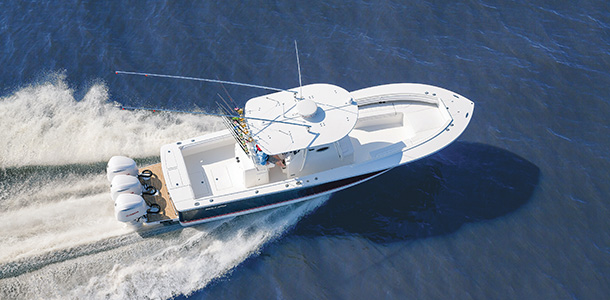
Offshore fishing boats become more versatile as segment sales climb
It’s smooth sailing in the fishing boat segment.
In years when some of the industry has seen slow or flat growth, fishing boats have continued to climb. As of December 2014, sportfishing boat sales are up by over 10 percent and outboard boats over 15 feet are not far behind.
OEMs are extremely confident about their future, calling the segment “as hot as you can get.” Several OEMs claim they have surpassed their pre-recession sales highs. The state of the industry, from the fishing boat market’s perspective, couldn’t be better right now. But don’t take their happiness as arrogance: The segment has put in the time and effort to build their way back.
“Everybody has worked hard to get back to this point,” said Bryan Harris, vice president of sales at Everglades Boats. “There’s not anybody in the fishing boat industry that wasn’t damaged severely during the recession, but everybody has come back and everybody works together.”
This growth can be largely attributed to improved technology, user-friendly boats and broad products with a host of amenities. Fishing boats are no longer just for fishing, and the adaptability of boat builders has helped make the segment strong.
“The focus is not on putting out so many boats but satisfying the consumer’s wants and needs. I think it’s a much healthier business right now,” said Peter Truslow, president at EdgeWater Boats.
Technology is king
A gradual but significant shift has occurred in the marketplace toward center consoles, particularly large center consoles. Fishing boats as large as 40 feet or longer have grown in popularity and many boat builders are designing larger vessels than they have in the past. Most OEMs are focusing on hulls of at least 25 feet or more.
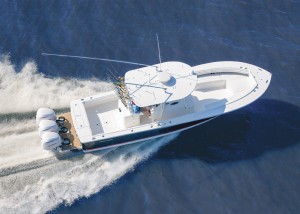
“Center consoles are getting bigger and bigger,” said Harris. “Nobody would have ever thought 10 years ago there’d be a 42-foot center console.”
Joan Maxwell, president of Regulator Marine, attributes the technology of large outboard engines to the success of these boats, which enables boat builders to push an outboard-powered boat of exceptional size.
The ease of operation of an outboard boat, low maintenance and flexibility of center console vessels also drive this new focus. With an outboard engine, consumers can simply get on the boat and turn on the key as if they were using a car, says Maxwell. Push-to-start engines also simplify the operation of the boat, which is another attractive feature.
In addition to ease of functionality, consumers are also calling for improved navigational systems. Simrad Yachting, which designs and manufactures marine navigation systems, recently partnered with Maverick Boat Company on the Cobia 334, which features the Simrad NSO evo2 glass bridge as its standard navigation system. The NSO evo2 includes two multi-functional devices in one, offering dual-discrete video output with full HD resolution. Simrad’s navigational systems connect with digital switching communications and allow boaters to read engine data.
 For Mercury, Simrad manufactured Vessel View, which uses the Mercury interface and allows the boaters to not only read engine data, but to control their Mercury engine directly from the Simrad display.
For Mercury, Simrad manufactured Vessel View, which uses the Mercury interface and allows the boaters to not only read engine data, but to control their Mercury engine directly from the Simrad display.
Matt Vranich, director of boat builders and OEM sales at Navico, Inc. – which owns Simrad – says consumers want better radar technology that is simple to use. Simrad is focused on anticipating solutions for integration they can provide at the factory level for OEMs to customize navigation based on their clientele.
“[Simrad] is fulfilling a need, and perhaps even an expectation, of younger generations that get into fishing where they’re so used to having an iPhone or something in their hands that controls everything in their lives,” said Vranich. “[Technology] is certainly making the experience much better.”
“We’ve got to make it easier all the way around. We can’t have the electronics [where] you have to get the book out every time that you use them,” said Maxwell. “Technology has driven us part of the way and our customer has driven us most of the way.”
Truslow expects navigation, engine control systems and switching will all be digitally connected in boats going forward to meet consumer demands. On EdgeWater’s new 36-foot 386 CC, which will be introduced at the Miami International Boat Show, C zone digital switching
connects with NMEA 2000 communication.
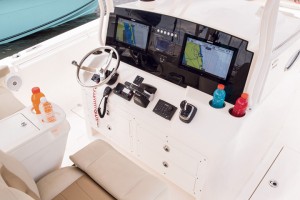
NMEA 2000 allows for a reduction in the number of wires on a boat, which considerably reduces weight. Everything from navigation information to engine data can be shared and displayed across the network. The cable and connector system allows for easy installation of future products.
“It’s not technology for technology’s sake – it’s actually technology that makes the boats perform better and more fun to operate,” said Truslow. “The technology makes the boats better. It makes them safer. It makes them stronger.”
According to Mark Reedenauer, managing director of the National Marine Electronics Association, NMEA 2000 interface is now widely used by all major marine electronics manufacturers on vessels of all sizes, from freshwater bass boats all the way up to large sport fishing vessels, and everything in between.
Dave Wallace, vice president of operations at Scout Boats, says NMEA 2000 simplifies electronics on Scout’s LXF series.
Maxwell believes this ease of use with technology will provide confidence to consumers. She points to Yamaha’s Helm Master package used in Regulator’s boats, which she says makes the boat easier to handle at dock.
“What the larger boat will give [the fishing community] is that confidence to go further offshore with range, with comfort and [easy-to-use technology] to come back in and not feel like a fool as [they’re] docking the boat,” said Maxwell. “How do you take somebody who has more money than they’ve got time and to make sure that time is well-spent with his family and his friends? He doesn’t want that boat to be something he has to learn to operate.”
Family and flexibility
The consumers driving the offshore fishing boats are not who they used to be. In the past, extensive prior knowledge was necessary to operate an offshore fishing boat. Today’s consumer is much more family-focused and requires a boat with features that are user-friendly to everyone on board.
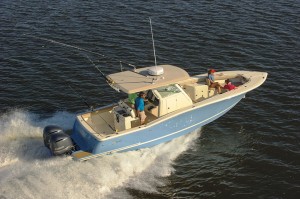
“People want to have more flexibility in the products that they’re using,” said Maxwell.
For a fishing boat to be family-friendly, consumers are beginning to ask for more and more amenities that are not normally attributed to a fishing boat. Parents want somewhere for their children to get out of the sun, cup holders for drinks, dive doors to get into the water and other comfort features.
“People want boats that can serve multiple purposes,” said Harris. “The kids can get pulled on tubes and they can go paddleboarding. [They want] many, many uses versus just the utilitarian center console fishing boat.”

As an example of the prioritization of amenities by OEMs, Scout Boats has included features such as tempered glass enclosure T-tops, 12-volt refrigerators in the cockpits, sound systems with USB drive and remotes with the ability to operate via a smartphone, built-in smokeless electric grills, sleeping accommodations under the console and more in its boats. Wallace likens the addition of these many amenities to trends exhibited in the automobile industry.
“The wife and kids are more today than ever a key to the buying decision. Just like what the automobile industry has done with pickup trucks by adding all the features of a luxury car we at Scout have done the same with the ‘fishing boat.’ Just like many pick-up trucks owned today, they will never have a yard of dirt in the bed, many of our ‘fishing boats’ will never have a fish in the cockpit,” said Wallace.
One amenity seems to stand out among the rest as a top priority for consumers: better, more comfortable seating.
“Fifteen years ago, if you were on a center console fishing boat, you were basically sitting on a bucket. There wasn’t a lot of seating,” said Harris.
Carolina Skiff has created horseshoe seating in the bow of their boats that can fit a table if desired. If the seat cushions are removed and the hatches opened, it becomes a full-fledged fish box in a horseshoe style, says Robert Sass, national sales and marketing director of Carolina Skiff, LLC. These hybrid-style products that are focused on both fishing and family-friendly comfort are a huge emphasis going forward.
Sass says there are fewer buyers out there today than back in the glory days and the market share is getting thinner, which makes it more difficult to approach the fishing boat consumer.
“Ten years ago, it was normal for a guy to have two boats: a fishing boat that he used and … a family boat,” Sass said. “Now people need a boat to do it all. They need one boat that is multifunctional … [it] can take them out and go fishing and it can take the family out to go cruising.”
Truslow agrees and would add that the fishing boat consumer today is a very busy individual.
“People seem to have less time to fish,” said Truslow. “I do worry about some of these longer-term trends where people are spending less time in the outdoors.”
The consumer is also very budget-minded. They pursue very particular boats on a rigid budget, and this causes manufacturers to fight for their position in the marketplace, says Sass.
“They’re doing a lot of research. They’re really trying to see what’s going on. They set a budget and that’s what they go for,” said Sass. “Fishing and boating is not leisure – it is lifestyle for people. They’re just doing it on smaller budgets, so you have to account for that.”
“With the cost associated with boating it is much better to ‘cast the net’ to a broader marketplace. To be one dimensional in my opinion is a mistake,” said Wallace.
Putting as much information as possible in the consumers’ hands, letting the product sell itself and evolving with the needs of the consumer is the best way to stay competitive in this new marketplace, says Sass.
Boats with personality
Historically, white vinyl was the material and color of choice in fishing boat interiors, but Scout Boats has noticed customers are looking for customizations in color and other amenities that they are offered in their automobiles and yachts. Before the recession, most fishing boats didn’t have air-conditioned center consoles, glass enclosures, side doors and painted engines. The types of amenities were unimportant – now consumers expect them.

“The consumers that are buying [offshore fishing boats] today are used to having a lot of the features,” said Wallace. “[New consumers] expect more than what the older buyers used to want or need.”
In the case of customized painted engines, customers pay in excess of $3,500 to paint one engine, which means a quad boat can cost up to $14,000.
While it may seem like a huge expense for nothing more than aesthetics, Wallace says it’s a feature customers are willing to pay for. He says Scout Boats has more requests for special features than ever before and as of the end of 2014, Scout Boats sales were up 28 percent over its best year in 2007. Wallace attributes most of this success to their focus on customization.
“Our customers wants more than a boat,” said Wallace. “Manufacturers and dealers need to continue to give the customers what they want and what they expect, and give them an experience that will keep them going on the water.”
Reauthorizing the Magnuson-Stevens Act
The fishing boat segment has a lot to keep abreast with in terms of government legislation and the successful reauthorization of the Magnuson-Stevens Act should be a top priority. Once there are reports that an MSA reauthorization bill has either been introduced or one is imminent, the bill could have a chance of passing.
However, even with the new Republican-controlled 114th Congress under way, increasing interest in the 2016 presidential election could decrease an appetite in Congress to pass complex legislation, such as the MSA.
Jeff Gabriel, legislative counsel for the National Marine Manufacturer’s Association, says anyone concerned about MSA reauthorization should contact their representatives, regardless of their party, to express the importance of this legislation.
“[The fishing boat community] should never underestimate that the greatest lobbying force in this country is the American people themselves and they most certainly have the collective power to influence the direction and flavor of the 114th Congress,” said Gabriel.
The inclusion of the Morris-Deal Commission, which addresses the needs of the recreational fishing community, in the reauthorization is of utmost importance.
“Be mindful that recreational fishing is now competing with commercial fishing when it comes to government regulation,” said Truslow. “Politicians need to understand that good science that will allow the fish to survive is essential.”
“As boat dealers and boat manufacturers we should be very concerned if Magnuson-Stevens isn’t made more friendly to the 11 million fishing hobbyists and the businesses that cater to them such as boat dealers and boat manufacturers,” said Wallace. “Statistically, sport fishing has a greater economic impact than the commercial fishing industry, and if this isn’t recognized in Washington it will have an adverse effect on our businesses.”
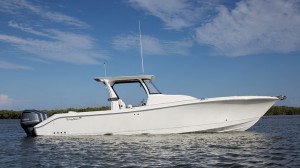
You can receive alerts on MSA reauthorization and other issues by signing up at www.boatingunited.com.
Concerns exist not just at the national level – local markets are also experiencing restrictions. Access to certain species of fish is becoming limited in areas such as Florida and the Northeast U.S., which is concerning for the fishing boat segment as consumers have less capability to participate in the sport they love.
“It is incumbent upon all of us to be aware of any type of agency that make be looking to restrict our right to fish – either to take it completely away in an area or to restrict it,” said Maxwell.
Truslow recommends everyone become involved in their local markets to directly address these issues. A potential fishing ban that exists in Everglades National Park is deeply concerning to Truslow and he notes that bans of that type could arise in other regions. He also believes everyone should actively engage in local conservation efforts.
An optimistic future
Ultimately, a large number of fishing boat OEMs list any concerns about reaching consumers as minute. The outlook on the fishing boat segment is overwhelmingly optimistic and as long as manufacturers continue to create quality products that meet the various needs of the consumer, the segment will remain strong.
“What our customer continues to expect from us is the legendary ride, which our name has been build on, the fit and finish of our product, and the reliability of our product and the engines that we partner with. … He expects us to give him certainly some parts of technology but his primary focus is that ‘I want to get there comfortably, safely and I want to return the same way,’” said Maxwell. “The dealer and the manufacturer must partner very closely to make sure that, on our side, we don’t produce something that‘s a problem, and if there is a problem either caused by something we’ve not done or damage caused by a customer, that we get him quickly back on the water.”
“We don’t really have any bigger concerns other than … [making] a good product for the consumer to use,” said Sass. “There’s a future there for the fishing boat market. [The question is] where do you want to go?”




